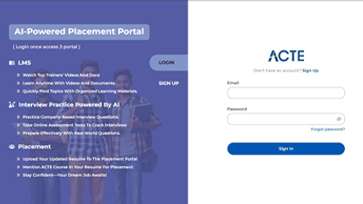Web design refers to the design of websites on the internet. Web design used to focus on websites for Desktop browsers, but the design of mobile browsers and tablets is becoming ever more significant since the mid-2010s.The look, layout and content of a website is worked up by a web designer in some circumstances. For example, the appearance concerns the colours, typeface and pictures utilised. The layout relates to the arrangement and categorization of information. A good site design is easy to use, attractive and suitable for the user group.A good web design is simple to use, attractive aesthetically and adapts to the website's user and brand. Many online pages emphasize simplicity, and no alien information and functionality can distract or mislead consumers. As a site which gains and promotes confidence for a target audience is the keystone of a web designer's work, it's crucial to remove as many probable conceivable causes of user annoyance.
The responsive and adaptive designs are two of the most prevalent website techniques for both desktop and mobile applications. In a reactive design, content moves dynamically according to the screen size; the content of the web site is fixed in design sizes according to common screen sizes in an adaptable design. To retain user confidence and commitment, it is vital to maintain a layout that is as uniform as feasible between devices. Since responsive design might offer problems, designers must take care to abandon control over the appearance of their work. They also have the advantage of possessing the content, although they may need to develop their abilities.
Depending on the manufacturing process they participate in, web designers employ a range of various tools. These instruments are upgraded by new standards and software throughout time, but their fundamentals stay the same. To generate web-formatted images or design prototypes, web designers are using both the graphics editor and the rast. W3C standards such as HTML and CSS, hand-coded, or WYSIWYG Editing Software, are included among the technologies used to construct websites. Other web design tools may be employed to guarantee that their site meets web accessibility requirements like markup validators and other usability and accessibility test tools.
On a website, marketing and communication design may detect what's working on its target market. The designer can therefore grasp the patterns of his or her public. This might be a specific age group or strand of culture. For example, (B2B) creating business-to-business Web sites might differ considerably with respect to a focused consumer website, such as a retail or entertaining website; Designers can also comprehend what sort of website they build. Aesthetics or the general appearance of a website may not conflict with clarity and accuracy or ease of navigation. Careful attention can be made.
The users' interpretation of a website content frequently depends on how the website functions. This is part of the design of the user experience. User experience includes layout, clear instructions and website labelling. How effectively a website user knows how to interact might also rely on the website's interactive design. If a person understands how beneficial the website is, he will continue to use it. It is more likely. Users with skills and knowledge about the use of the website may nonetheless find it more distinguishable but less intuitive or less user-friendly. However, less experienced users are
The quality of the page layout will influence part of the user interface design. For example, while developing a layout, a designer might evaluate if the website layout should be consistent on different pages. Page pixel width can also be regarded as essential for layout alignment of items. The most popular websites with constant widths usually have the same set width to correspond to the current most popular browser window, with the most popular screen resolution on the latest monitor size. Most pages also focus on aesthetic problems on huge displays.Fluid design enhanced the popularity of the browser about 2000.
After studying web design, students can accept employment both in the IT and non-IT industry in accordance with their professional preferences. Today, half the globe has access to internet sites, web designers are in significant demand for the digital exposure of companies across industries. For applicants with a web design degree, several employment opportunities are accessible. Some of the common profiles for work are :
- Designer of web
- Developer of Web Application
- Free designer
- Designer of Web Media
- Designer of flash media
- Designer Graphics
- Consultant in Design
- Programmer website
- Instructor for Web Design
Web Design Certificate :
- This course contains HTML, CSS, PHP and other languages required to construct a website. This course includes
- The schoolchildren are taught how to make a map, create a website with numerous pages, create a form and publish sites, using the same. Adobe Dreamweaver
- It also introduces the notion of a jQuery plugin, which improves user experience with slider effects.
- The course shows how vector animation and other visual effects are also carried out on the websites.
- To learn vector animation, Adobe flash is presented. The training gives you thorough insight into how to create a complete website.
Compensation:
A web designer's salary varies from business to firm, and you might receive an initial salary of 10000 to 25 000 per month if you're new in this area. You may easily profit from 25000 to 40000 per month with some expertise. There are numerous web designers that earn six figures.You may make $71,714 annually as a web designer abroad.
Web Designer Average Wage in India :
In India, the average wage for web designers is Rs 285K per year. The pay might range from Rs. 118,000 to Rs. 634K per year, depending on the region, amount of expertise, profile of the firm, etc.
Work and employment :
'In India and internationally, web designing provides a wide range of potential for the expanding IT sector.'You might work in a web design business or you can work as a freelancer after completing your web design degree. For the front end and back end web development projects there are thousands of firms who recruit web-developers. You may also work as a web designer independently and start up your own company. In this discipline, the main areas of career are:
Front end Developer :
The developer on the front end usually uses visuals that are available to the user on the customer's side.Developer background: the developer background is a person who is responsible.
Backend Developer :
The Backend Developer is someone who interacts with the server in order to create the backend. This web developer type is specialised in Php, Ruby, ASP.Net, Java, Cold Fusion and Perl.In the education business you can also work.The web developer's job profiles include:
- Web developer of the front end
- Web developer back end
- Developer of web application
- Analyst for design and design
- Analyst for senior web
- Analyst for Web Marketing
Make a designer key reasons :
1. Super demand :
Web designers are in great demand. In addition, firms are looking for exceptional people that are able to stay on the market and play more than one job.
2. Happy Pay :
Web designers may, as you can see, make an appealing wage. They get paid higher since they lower the company's operational costs. They remain in great demand because of their ability to work with diverse frameworks and techniques.In a number of industries they obtain jobs. Companies of many industries are seeking methods of using the newest technology. In financing businesses, banks, IT companies, and technology start-ups you will discover positions.
3. The flexibility of Creative :
You are aware of many developmental factors. You will thus also be able to work more flexibly. You may work on both the client and the database of the application.
4. Improved productivity :
You know several technologies as a web designer. This offers you a lead over others since technical decisions can be taken faster and the picture can be viewed.
Web Designer Salary Factors in India :
Multiple things may impact web designer's pay in India. See some of the elements impacting primary salaries:
- Experience
- Location
- Skillset
- Company
The web design sector has experienced several modifications from the early to mid-1990s to make it simpler for the web designer to live. Designers utilised in various browsers to worry about how long a website is downloaded and how it would work differently. The aim was previously to download a page in less than 50k with all its codes and pictures.The designer also has to use a number of techniques to guarantee that both Netscape and Internet Explorer have the same look. These are no longer, to a significant part, obstacles that offer the designer far more flexibility and time to concentrate on design itself.
Related salaries in comparison with web designers :
Consider the average wages in connection with the web designer pay in India.
- Average yearly pay for front end developers in India: CHF490,385
- Average yearly wage in India for developers in PHP: 287,651
- Average yearly pay for software engineers in India: 514,537 CHF
- Annual average web developer's pay in India: 308,040 daily.
- Average yearly wage in India for JavaScript Developers: 557,000 CAD
- Average yearly income in India for graphic designers: 300 671 daily.
Features of WEB DESIGNING :
Well-constructed Web Design Six Features :
How can you tell whether you're web designed in a good way? To build a website requires a mix of numerous elements and the combinations vary greatly depending on a single business's special demands. Given those variances, whether one site really is better and more efficient than another can be difficult to determine. An illuminating test is if it achieves the targeted goals.No matter what business or industry any firm may assess against a barometer, there are particular and telling aspects of a perfectly constructed website in spite of the numerous factors. Below are some of the main characteristics of the well.
1. Quality Web Content.
There’s one primary reason people use search engines and browse websites, and that is to search for information. People desire information everyday, and want it delivered in a fast and reliable fashion. Whether to entertain, entice or educate, superior content is a must in every frequently visited website, especially if search engine optimization is part of the website's overarching marketing strategy.For business websites, content should include important information and come in the forms that are pertinent to the business. Retail sites for example, need high quality pictures of their products, while consulting firms are more apt to highlight client testimonials. A best practice for most search engine optimisation gurus is also ensuring the most relevant content is prominent on the webpages.
2. Clear, User-friendly Navigation.
A stellar web design must contain a user-friendly navigation scheme that allows visitors to quickly find the information needed. Important links must be easy to find and given logical, simple, and include easy-to-understand labels. Calls to action are placed in conspicuous spots within the navigation’s scheme. If there is a plethora of content, then a search box is suggested to make it faster to reach more specific pages within a website.
3. Simple and Professional Web Design.
Bells and whistles may seem nice in concept, but they rarely add much value to an effectively constructed and sensible web design. Typically, the websites best at effectively converting site visitors into buying customers, maintain an attractive layout, but keep it clean and simple. Google is an excellent example of such a site. Actually, users found Google’s initial design over simplified during the initial testing phases. Thus in order to keep a simple interface, but prevent the appearance of site constructed without much thought, Google added the ‘I’m Feeling Lucky’ button underneath the search box. Despite the fact that hardly anyone clicks on this button, its addition balances the layout in such a way that delivers a better user experience.To keep websites simple, without making them look bland such as in Google’s case, a balanced distribution of content and graphics is required and the use of slightly contrasting colours and clear fonts is key. Visit http://www.thewebshowroom.com.au/balancing-web-graphics-text/ for more information on balancing graphics and content in any site's web design. Colours that are scream, are overtly contrasting, and font sizes that are difficult to read will put a strain on visitors’ eyes.Also, one should break up sizeable blocks of text with either spacing or images as appropriate.
4. Webpage Speed.
People inherently lose patience quickly, and that holds true when visiting a website. The longer a website takes to load, the more likely a person will leave before it fully renders. Beautiful graphics and substantial content become useless if a site’s speed hampers its ability to deliver content quickly.Several factors affect site speed, including server speed, the number of graphics, website traffic, etc. A web design company must make sure to minimise all controllable factors slowing down site speed by using reliable site hosting, proper website code, and optimised graphics.
5. Search Engine Optimisation.
A well-designed website generally will receive many visitors, and one method to attract visitors is search engine optimisation. This entails the insertion of search keywords in website content, an appropriate link profile, social media signals, and over 200 other factors. Just as The Web Showroom developed a resources setion for web design, we also created a search engine optimisation resources to help company's improve their rankings.
6. Web Compatibility.
The variety of browser and platforms which one can now be view web design can present a challenge to developers, but talented ones are accustomed to handling such factors. A site should easily render on various resolutions, screen sizes, and browsers; and with the increasing popularity of mobile devices, websites should function properly on the plethora of these types of devices.When it comes to web design, remember that not all that glitters is gold. Know what truly makes a well-built site and you’ll soon find your website quickly on its way to attracting and retaining customers.
The top 8 benefits of having a professional website design include :
Provides a Better First Impression :
Having a website that is professionally designed ensures your site will give visitors a good first impression. Amateur websites can come across as unprofessional and less credible.
Helps Keep Up with Competitors :
In order to keep up with competitors you need a website that is equipped with the latest design trends, which can be achieved through a professional website design.
Boosts Revenue :
A professional, well-designed website will attract visitors and help boost revenue as a result.
Improves Search Rankings :
An out of date and unprofessional website will only hinder search ranking performance, so it’s best to move forward with having a professional website design, so that you keep your website moving up in rankings among popular search engines like Google.
Reduced Bounce Rates :
A professional website design not only attracts visitors to your site, but helps keep them there, exploring what your business has to offer.
Saves Money :
By having a professional website design in place right from the beginning, you avoid having to update an amateur website that was designed poorly, which saves you money.
Makes it Simpler to Add Future Website Functionality :
If, down the road, you wish to add some additional functionalities to your website, a professional website design will provide the foundation needed to do this task easily.
Establishes Consistent Brand Identity :
Establishing a consistent Brand identity is essential for building business credibility and trustworthiness,and having a professional website helps you communicate your brand’s story more effectively
Project of Web Designing :
- One-page layout
- Login authentication
- Product landing page
- Giphy with a unique API
- JavaScript quiz game
- To-do list
- SEO-friendly website
- JavaScript drawing
- Search engine result page
- Google home page lookalike
- Tribute page
- Survey form
- Exit plugin
- Note log
- Social share buttons
- Toast notifications
Web Developer's Responsibilities :
A web developer's responsibilities tend to extend beyond scripting. The following tasks might be part of your position (in addition to the actual programming part).
Meeting customers:
You may need to meet customers face-to-face to comprehend and communicate with them throughout the entire project - particularly when working for a small business or an independent employee.
Customer Research:
If your firm has done a thorough investigation and survey of customers before starting developing the project, you might need to see the data firsthand to grasp the context.
Partner with other teams:
presumably UX designers, data analysers, project managers and product designers will be your company. It is very probable that you will collaborate at one point or another with each of these teams to make sure the site is beautiful and gathers the correct user information.
Quality testing:
testing is an important component of the process of development. Before your website or app goes live, you will solve your problem, check for bugs, and test your sites on different browsers and devices.A one-man Web contractor or a member of a 30-man engineering group will look greatly different in everyday life. Please take some serious steps before signing or accepting an offer. Think seriously about the elements that provide you the greatest satisfaction in your career. Programming is a multi-facetted talent that may lead you down a range of very diverse routes.
Successful Web Developer Achievements :
You might find your work with an excellent portfolio and a strong understanding of HTML. But other skills can assist promote your profession and cannot be taught in a one-hour Youtube video.In the area of web development, the following four abilities will help you flourish. Perhaps these come for you naturally; but if they don't, you can look at every site you develop in detail, the logical resolution of problems, the creativity and communication.
- Please take care of detail: The 404 might even be the most minute kind. Programmers learn to read their code repeatedly by checking for mistakes and finding efficiency. It requires patience, laser focus and an ability to look with an impartial eye at your own work.
- Logical thought: The rules and definitions are based on programming languages. If you are inherently competent to think rationally about difficulties, you will find these languages much faster. You will have a nutshell to split statements into their essential pieces and to forecast logical results, as you observe them in action.
- Creativity: Developers must discover the most elegant end-user solution. You discover that there is seldom one answer to a problem when you embark on increasingly complicated projects: you could have several paths at your disposal, and it requires a creative mind to conceive how they perform.
- Communication: You will need to interact with stakeholders or team members throughout your projects, whether you are a comprehensive engineering department or go alone as a contractor. Keep your team open to the ideas of designers, customers and others and talk about barriers in advance. Promoting open communication channels will make your work more polished and assist you
Growth Opportunities :
A talented developer will manage a team and will be able to advance to the technical director or CTO. This offers potential for more salaries and new tasks but also greater accountability and less front-line coding.
- Senior and leading designers still spend time programming, but they take on the most difficult jobs and are more self-sufficient. They conduct team meetings and serve as experienced specialists who are ready to help novice team members answer issues.
- Get ready for a whole new sphere of responsibility, if you get to the technical director. Technical directors guide the management of the entire department.Personnel, tools and budget considerations. If you have done this, your coding skills have already been proved. You will now need to step up with leadership, delegation and management abilities for projects.
- If you're following a leadership role you may ultimately be a Chief Technology Officer with your programming skills. As CTO, in real programming, you will no longer have your hands. The development teams will spend their time developing policies, processes and goals. The new goods, features and big investments for the firm will be called up for shots.
How to start a web-based career :
Some opt to graduate in computer science with an Associate or Bachelor. These programmes include computer and logic essentials, but you do not have to get a degree or perform excellently in your first job.Fast lessons online are popular too. Although this is a fantastic method to get your feet moist, if your ultimate objective is your job, it may become a long journey. The first time that you and a computer are learning programming, it is frustrating, without live help. And building a career in Internet development is a complicated process requiring more than just fundamental Java and Python expertise.Structured online software engineering courses such as ourselves focus on the qualifications that you are actually going to apply for and paire with a personal mentor who is available to answer questions, to help you think as a programmer and to accomplish your professional objectives. You will construct a portfolio that will attract and offer top employers. And our grads don't simply work on the land: they're getting promotions and developing long-term professions that they enjoy.
































